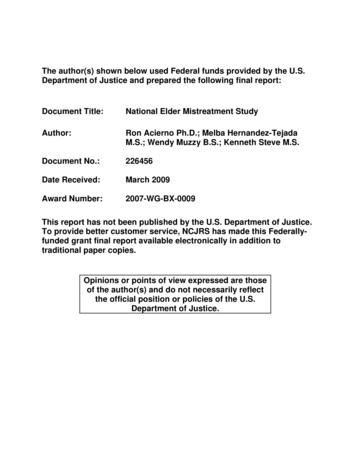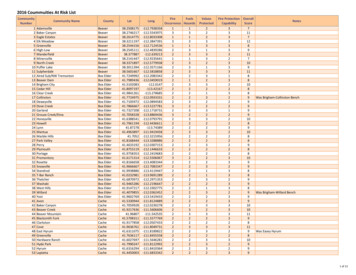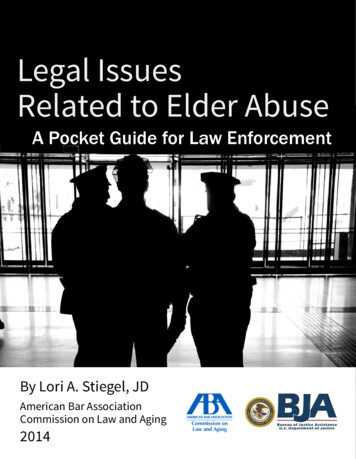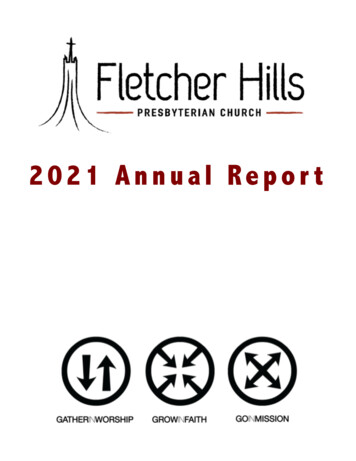
Transcription
The author(s) shown below used Federal funds provided by the U.S.Department of Justice and prepared the following final report:Document Title:National Elder Mistreatment StudyAuthor:Ron Acierno Ph.D.; Melba Hernandez-TejadaM.S.; Wendy Muzzy B.S.; Kenneth Steve M.S.Document No.:226456Date Received:March 2009Award Number:2007-WG-BX-0009This report has not been published by the U.S. Department of Justice.To provide better customer service, NCJRS has made this Federallyfunded grant final report available electronically in addition totraditional paper copies.Opinions or points of view expressed are thoseof the author(s) and do not necessarily reflectthe official position or policies of the U.S.Department of Justice.
This document is a research report submitted to the U.S. Department of Justice. This report has notbeen published by the Department. Opinions or points of view expressed are those of the author(s)and do not necessarily reflect the official position or policies of the U.S. Department of Justice.FINAL REPORT:The National Elder Mistreatment StudyNATIONAL INSTITUTE OF JUSTICERon Acierno, PhD; Melba Hernandez-Tejada, MS; Wendy Muzzy, BS; Kenneth Steve, MS
This document is a research report submitted to the U.S. Department of Justice. This report has notbeen published by the Department. Opinions or points of view expressed are those of the author(s)and do not necessarily reflect the official position or policies of the U.S. Department of Justice.TABLE OF CONTENTSAbstract . 4Executive Summary . 5Implications for Policy and Practice. 13Project Description . 15Overview . 15Goals and Objectives . 15Background. 15Scope and Methodology. 21Field Outcomes . 31Variable and Risk Factors Definitions . 32Data Analysis and Statistical Plan. 37Detailed Findings . 38Sample Characteristics . 38Emotional Mistreatment . 38Physical Mistreatment . 42Sexual Mistreatment . 46Neglect. 48Financial Mistreatment . 53Proxy Interview Findings . 58Analysis and Discussion . 62Prevalence Data: Summary and Conclusions. 62Proxy Data: Summary and Conclusions. 70Conclusions and Implications of Findings . 73Specific Suggested Areas of Intervention and Prevention . 73Biographical Notes on Authors and Institutions . 75References. 77
This document is a research report submitted to the U.S. Department of Justice. This report has notbeen published by the Department. Opinions or points of view expressed are those of the author(s)and do not necessarily reflect the official position or policies of the U.S. Department of Justice.Appendix A: Pretest Advance Letter . 79Appendix B: English Language Questionnaire . 80Appendix C: Spanish Language Questionnaire . 130
This document is a research report submitted to the U.S. Department of Justice. This report has notbeen published by the Department. Opinions or points of view expressed are those of the author(s)and do not necessarily reflect the official position or policies of the U.S. Department of Justice.ABSTRACTIntroduction The overall aim of this project was to conduct a national epidemiologicalstudy to determine prevalence and risk factors for elder mistreatment in communityresiding older adults, defined generally as physical, sexual, emotional, neglectful, orfinancial mistreatment of a person age 60 years or above. A second goal was todetermine whether proxy reports of mistreatment would yield prevalence estimatessimilar to those of older adult respondents themselves, thereby demonstrating thevalidity of an alternate method of assessing elder mistreatment.Method Random Digit Dialing methodology was used to derive a nationallyrepresentative sample (based on age, race, and gender) of 5,777 older adults (targetgoal 4,000) and 813 proxy respondents (target goal 500) for this study. Participantswere interviewed via telephone in English or Spanish about a variety of mistreatmenttypes and mistreatment risk factors, in addition to questions regarding health, socialsupport, and demographics. Specific elder mistreatment categories included emotional,physical, sexual, financial, and neglect.Results The cooperation rate was 69% for the sample. 60.2% of the older adults werewomen and 39.8% were men. The average age of respondents was 71.5 years (SD 8.1) with a range of 60 to 97 years. Of the 5,777, about 57% were married orcohabitating, 12% were separated or divorced, 25% were widowed, and 5% were nevermarried. Considering race in order of magnitude, about 85% indicated that they wereWhite, 7% Black, 2% American Indian or Alaskan Native, 1% Asian, 0.2% PacificIslander, and the remainder chose not to identify. Considering Ethnicity, 4.3% indicatedthat they were of Hispanic or Latino origin.In addition to factors such as race and gender, the study sample was alsocharacterized in terms of important contextual risk factors that might serve to increaseor decrease risk of elder mistreatment, yielding the following risk factor information: lowhousehold income (i.e., less than 35,000 per year combined for all members of thehousehold) was reported by 45.7% (2,262); being unemployed or retired was noted by80.9% (5,174); poor health was self reported by 22.3% (1,279), a prior traumatic event(defined below) was reported by 62.0% (3,566). Another 43.6% (1,379) indicated thatthey currently felt that they had very low levels of social support. Fully 40.8% (2,329)used social services of some form, and 37.8% (2,176) reported that they needed someassistance with activities of daily living (ADL). In order to simplify analyses, we alsodichotomously grouped participants into two age groups: ‘younger old’ age 60 to 69(49.9% of the sample), and ‘older old’ age 70 (50.1%, of the sample).Past-year prevalences were as follows: emotional mistreatment: 4.6%; physicalmistreatment: 1.6%; sexual mistreatment: 0.6%; current potential neglect: 5.1%; currentfinancial exploitation by family: 5.2%. Lifetime financial exploitation by a stranger wasalso obtained: 6.5%. Considering only emotional, physical, sexual, and potential neglect(i.e., excluding financial mistreatment), 11% reported at least one form of past yearmistreatment, 1.2% reported 2 or more forms of past year mistreatment, and 0.2%reported 3 forms of mistreatment. In contrast to expectations, proxy reports were notuseful in identifying mistreatment, with the exception of family-member perpetratedfinancial exploitation. Thus, alternative methods of mistreatment prevalence estimationwill need to be developed for community residing, cognitively impaired older adults.Overall, the elder mistreatment assessment strategy used in this study provedextremely effective in detecting all forms of abusive behaviors.
This document is a research report submitted to the U.S. Department of Justice. This report has notbeen published by the Department. Opinions or points of view expressed are those of the author(s)and do not necessarily reflect the official position or policies of the U.S. Department of Justice.EXECUTIVE SUMMARYThe overall aim of this project was to use Random Digit Dialing telephone surveymethodology to conduct a national epidemiological study to determine prevalence andrisk factors for elder mistreatment, defined generally as physical, sexual, emotional,neglectful, or financial mistreatment of a person age 60 years or above. A second goalwas to determine whether proxy reports of mistreatment would yield prevalenceestimates similar to those of older adults respondents themselves, therebydemonstrating the validity of an alternate method of assessing elder mistreatment (forexample, in cognitively impaired older adults who could not participate in surveyresearch). We obtained the following past-year prevalences: emotional mistreatment:4.6%; physical mistreatment: 1.6%; sexual mistreatment: 0.6%; potential neglect: 5.1%;current financial exploitation by family: 5.2%. Lifetime financial exploitation by non-familywas: 6.5%.MethodWe used Random Digit Dialing methodology to derive a nationally representativesample (based on age, race, and gender) in order to measure elder mistreatment in theUS community-residing population. We exceeded our recruitment goals by almost 50%.Specifically, we interviewed individuals from 6,590 randomly selected households. Ofthese households, interviews were collected from 5,777 older adults (target goal 4,000),and 813 individuals who lived with or cared for older adults, here classified as ‘proxy’respondents (target goal 500). Participants were interviewed via telephone in English orSpanish about a variety of mistreatment types and mistreatment risk factors, in additionto questions regarding health, social support, and demographics. Specific eldermistreatment categories included emotional, physical, sexual, financial, and neglect.ResultsThe cooperation rate was 69% for the sample. 60.2% of the older adults werewomen and 39.8% were men. The average age of respondents was 71.5 years (SD 8.1) with a range of 60 to 97 years. Of the 5,777, about 57% were married orcohabitating, 12% were separated or divorced, 25% were widowed, and 5% were nevermarried. Considering race in order of magnitude, about 85% indicated that they wereWhite, 7% Black, 2% American Indian or Alaskan Native, 1% Asian, 0.2% PacificIslander, and the remainder chose not to identify. Considering Ethnicity, 4.3% indicatedthat they were of Hispanic or Latino origin.In addition to factors such as race and gender, the study sample was alsocharacterized in terms of important contextual risk factors that might serve to increaseor decrease risk of elder mistreatment, yielding the following risk factor information: lowhousehold income (i.e., less than 35,000 per year combined for all members of thehousehold) was reported by 45.7% (2,262); being unemployed or retired was noted by80.9% (5,174); poor health was self reported by 22.3% (1,279), a prior traumatic event(defined below) was reported by 62.0% (3,566). Another 43.6% (1,379) indicated thatthey currently felt that they had very low levels of social support. Fully 40.8% (2,329)used social services of some form, and 37.8% (2,176) reported that they needed some
This document is a research report submitted to the U.S. Department of Justice. This report has notbeen published by the Department. Opinions or points of view expressed are those of the author(s)and do not necessarily reflect the official position or policies of the U.S. Department of Justice.assistance with activities of daily living (ADL). In order to simplify analyses, we alsodichotomously grouped participants into two age groups: ‘younger old’ age 60 to 69(49.9% of the sample), and ‘older old’ age 70 (50.1%, of the sample).No differences were observed based on Hispanic ethnicity in any mistreatmenttype. However, there were differences between Whites and Non-Whites on measures ofPhysical Mistreatment, and this dichotomous variable is included in all univariateanalyses below.Emotional MistreatmentApproximately 4.6% of adults over age 60 reported experiencing some form ofemotional mistreatment in the past year, and only 8% of these individuals reported theevent to the police. This contrasts with a prevalence of 9% reported by Laumann,Leitsch, and Waite (2008) in their recently completed nationally representative sampleof older adults for what they called 'verbal mistreatment.'Exhibit 1: Elder Mistreatment for Both Past Year and Since Age 60 Time Frames20.0%Since Age 60Past Year / Current16.0%Lifetime14%12.0%8.0%7%5%5%5%4.0%2% 2%0% 1%0.0%EmotionalPhysicalSexualNeglectFinancial Family Financial StrangerComparison of our definition of emotional mistreatment with their definition ofverbal mistreatment explains part of this discrepancy, as their definition was somewhatliberal, and defined by a 'yes' response to the question "Is there anyone who insults youor puts you down?" When considering our more conservative definitions (see fullreport), the lower estimates in our study are therefore not surprising. As with all forms ofelder mistreatment, strangers were not usually the perpetrators. Instead, perpetratorswere known to their older adult victims, and were family members in more than half thecases. Among known perpetrators, about a fifth were abusing substances around thetime of mistreatment, and the same proportion had some form of mental illness. Almost
This document is a research report submitted to the U.S. Department of Justice. This report has notbeen published by the Department. Opinions or points of view expressed are those of the author(s)and do not necessarily reflect the official position or policies of the U.S. Department of Justice.half the perpetrators were unemployed and socially isolated. These emotionalmistreatment perpetrator characteristics appear to define a group of individuals withlimited social resources who are often in need of services to reduce substance abuseincrease employment, and deal with ongoing emotional problems. These perpetratordeficits may present targets for intervention which have the secondary benefit ofreducing elder mistreatment.Exhibit 2: Perpetrators of Most Recent Emotional Mistreatment EventO ther relative13%R efus ed9%C hildren/G rand19%S trang er9%A c quaintanc e25%P artner/S pous e25%The ‘younger old’, here defined as below age 70, were at 3 times the risk ofemotional abuse than those over age 70. This is consistent with recent findings ofLaumann et al. (2008) and in contrast to earlier findings that our ‘oldest old’ are atincreased risk of mistreatment (Tatara, 1997), but this difference may be due to the factthat we did not include any institutionalized older adults (a group over-represented bythe ‘oldest old’) or their representatives in our study sample. The fact that most abuserswere known to the victim indicates that this form of mistreatment is probably part of along-term pattern of interaction between these individuals, and probably began prior toolder adulthood.Also at a three-fold elevated risk were those older adults reporting very lowsocial support. The risk of negative outcomes associated with low social support is atheme echoed across mistreatment types, and speaks to the importance of consideringan older adult’s connection and utilization of community and interpersonal resources toprevent mistreatment. Risk was doubled for individuals who needed assistance in dailylife activities and in those with prior traumatic event experiences. The greater need forhelp and assistance of some older adults in accomplishing everyday activities appearsto elicit verbal abusiveness from caregivers. While older theories of caregiver stress asa causative factor in elder mistreatment have been debated (Wolf, 1988; Bristowne &Collins, 1989; Homer & Gilleard, 1990; Pillemer & Suitor, 1992), some indirect and
This document is a research report submitted to the U.S. Department of Justice. This report has notbeen published by the Department. Opinions or points of view expressed are those of the author(s)and do not necessarily reflect the official position or policies of the U.S. Department of Justice.limited support for this presumption is given here for emotional mistreatment (but not forphysical or sexual mistreatment, or neglect, as noted below).A final interesting finding regarding elder emotional mistreatment was the riskassociated with being employed, a risk maintained even after the effects of othervariables were controlled. Note that this does not mean that emotional mistreatmentoccurred at work per se, however, these data do indicate that this possibility should beexplored, and if observed, interventions to reduce workplace mistreatment of olderadults developed.Physical MistreatmentThe prevalence of elder physical mistreatment was 1.6%. This prevalence is 8times higher than that detected by Laumann et al. in their nationally representativestudy (0.2%) and speaks to the methodological sensitivity of our assessment strategy.The aforementioned study asked only one question ("Is there anyone who hits, kicks,slaps, or throws things at you?") with no contextually orienting preface statements. Bycontrast, our questions were structured to build on research with younger adults whichrevealed that survey respondents have a tendency to underreport 3 types of events:those they did not report to police, those that were not perpetrated by strangers, andthose that happened more than a year ago. Thus, early research with younger adults(Kilpatrick et al., 1992) demonstrated that it is necessary to include a contextuallyorienting preface statement to frame mistreatment questions so that respondents are'primed' to report non-stereotypic events; in other words: those perpetrated by nonstrangers, over a year ago, that were not reported to police. Ironically, these are themajority of events. The differences in prevalence rates between our study and that ofLaumann et al. highlights the need for this type of assessment strategy.In this sample, fully 31% reported physical mistreatment to police. Strangersaccounted for only 3% of physically assaultive behavior, compared to 76% for familymembers, indicating that any intervention to prevent this form of elder mistreatmentmust be directed at domestic relationships, and should probably borrow heavily fromdomestic violence research with younger adults. Perpetrators of physical assault weremore likely to be abusing substances at the time of assault than those of emotionalabuse, and were more likely to have histories of mental illness. Rates of unemploymentand social isolation approximated those of emotional mistreatment perpetrators. Takentogether, it appears that perpetrators of physical assault are frequently a socially andvocationally dysfunctional group of individuals. While these are significant problems,clear targets for intervention along these lines can be derived.
This document is a research report submitted to the U.S. Department of Justice. This report has notbeen published by the Department. Opinions or points of view expressed are those of the author(s)and do not necessarily reflect the official position or policies of the U.S. Department of Justice.Exhibit 3: Perpetrators of Most Recent Physical Mistreatment EventO ther relative9%R efus edS trang er2%3%C hildren/G rand10%A c quaintanc e19%P artner/S pous e57%In terms of risk factors, only low age and low social support predicted physicalmistreatment, but both of these did so at very high levels. Thus, as with emotionalmistreatment, efforts should be directed toward increasing older adult’s social support,perhaps in the form of maximizing their connection with and utilization of communitybased resources. This would have the potential effect of not only reducing eldermistreatment, but also building resiliency against a variety of other negative health andmental health outcomes previously linked to low social support (e.g., Acierno et al.,2004).Sexual MistreatmentThe rate of reported sexual mistreatment was very low, with less than 1% ofrespondents reporting this type of mistreatment in the past year. Unfortunately,contemporary comparison with other elder mistreatment surveys is not possible, asLaumann et al. did not collect sexual mistreatment data. Approximately 16% of victimsreported sexual mistreatment to police; which is a somewhat higher reporting rate thanthat observed in younger adults (Kilpatrick et al., 1992), despite fact that majority wereperpetrated by family members (52%) relative to strangers (3%). The finding that olderadults appear to be more likely to report this form of mistreatment than younger adults isa positive one only when considering reporting rates of one age group relative to theother. On the other hand, fully 85% of older adults who are sexually mistreated do notreport the event to police or other authorities.Family members were responsible for about half of the reported sexualmistreatments, with partners and spouses specifically accounting for 40%. This echoesrates and distributions noted in younger adults, and indicates that a significantproportion of sexual mistreatment of older adults is a form of domestic violence.
This document is a research report submitted to the U.S. Department of Justice. This report has notbeen published by the Department. Opinions or points of view expressed are those of the author(s)and do not necessarily reflect the official position or policies of the U.S. Department of Justice.Exhibit 4: Perpetrators of Most Recent Sexual Mistreatment EventO ther relative12%R efus ed5%S trang er3%A c quaintanc e40%P artner/S pous e40%The predictor set of risk factors for sexual violence was based on very smallsample sizes, and risk ratios should be considered somewhat tentatively. As with mostforms of elder mistreatment, individuals with low social support were more likely toreport that they experienced sexual abuse, as were those who experience priortraumatic events. The continuing importance of perceived social support to the healthand well being of older adults is consistently reinforced by the present study.NeglectPotential neglect (defined here as instances where an older adult identified aspecific essential need that was not being met; but did not necessarily indicate thatanyone had been designated to meet that need) was reported by 5.1% of respondents.(Laumann et al. did not collect neglect data, and comparison rates are not available).Potential neglect was independently predicted by a large number of risk factors inmultivariate analyses, indicating multiple potential causal pathways, or, alternatively,multiple pathways for intervention. Specific risk factors included belonging to a nonwhite racial group, lower income, poor health, and low social support. These risk factorsappear to point to a need to enhance the overall level of, and connection withcommunity resources for older adults as perhaps the most appropriate and effectiveway to detect and prevent neglect.
This document is a research report submitted to the U.S. Department of Justice. This report has notbeen published by the Department. Opinions or points of view expressed are those of the author(s)and do not necessarily reflect the official position or policies of the U.S. Department of Justice.Exhibit 5: Perpetrators of Most Recent Neglect EventO ther relative7%R efus ed3%A c quaintanc e23%C hildren/G rand39%P artner/S pous e28%Financial ExploitationCurrent financial exploitation by family members in one form or another waspresent in over 5% of respondents, making this form of mistreatment by trusted othersunexpectedly common. Not surprisingly, older adults who were somewhat functionallyimpaired, as evidenced by their need for assistance with activities of daily living, weremost at risk. Disconcertingly, older adults who used social services were more likely tobe financially mistreated, perhaps indicating that interaction with service providerssomehow failed to act as a barrier against financial exploitation by family members,despite the increased potential for detection.Lifetime financial exploitation by strangers (about 6% of the sample), usually inthe form of fraud, is a form of mistreatment operating via very different mechanismsthan that perpetrated by family members. As such, it carried with it slightly different riskand protective factors. For example, financial exploitation by strangers was not affectedby older adult social service interaction. Not surprisingly, older adults with functionalimpairment, defined either as needing assistance with activities of daily life and poorhealth, were more likely to be targets of stranger-perpetrated financial exploitation. Moredifficult to explain is the finding that younger older adults, and older adults with priortraumatic experiences, were also at increased risk for financial exploitation. Withrespect to the latter risk factor, it may be the case that the neighborhood or communitylevel variables associated with traumatic events are the same as those associated withstranger perpetrated fraud, however, we did not collect data to identify these commonlinkages, and given the finding that prior exposure to traumatic events predicted manyforms of elder mistreatment, this might be an area worthy of study.
This document is a research report submitted to the U.S. Department of Justice. This report has notbeen published by the Department. Opinions or points of view expressed are those of the author(s)and do not necessarily reflect the official position or policies of the U.S. Department of Justice.Proxy Data: Summary and ConclusionsData were also collected from over 800 individuals who lived with or cared for anolder adult. These proxy reporters were included to determine if prevalences of reportedelder mistreatment would be similar to those reported by the older adults themselves. Ifthis were the case, an alternative method for assessing elder mistreatment (e.g., incognitively impaired older adults) would be identified (institutionalized older adults willrequire an entirely separate form of assessment methodology based on sentinel andtechnological reports; see the work of Lachs et al. in progress). Although prior studies(e.g., Pillemer and Finkelhor, 1988) indicated that proxy reports might actually be moresensitive to detecting elder mistreatment than older adult respondent reports, thisfinding was largely not supported here, with the exception of family-member perpetratedfinancial exploitation. For other abuse types, proxy reports produced significantly lowerestimates of emotional mistreatment, physical mistreatment, sexual mistreatment,neglect, and financial exploitation by strangers than did respondent reports. Thus,alternative methods of mistreatment prevalence estimation will need to be developed forcommunity residing, cognitively impaired older adults.SummaryOverall, the elder mistreatment assessment strategy used in this study provedextremely effective in detecting all forms of abusive behaviors. This finding is stronglysupported when contrasting this study's prevalence estimates to those derived fromanother nationally-representative study on the same age cohort conducted at roughlythe same time by Laumann et al. (2008). The present study found past yearprevalences of 4.6% for emotional mistreatment (compared to 9% by Laumann et al.who used an extremely liberal, single question assessment of 'verbal' mistreatment);1.6% for physical mistreatment (compared to 0.2% by Laumann et al.), 0.6% for sexualmistreatment (not measured by Laumann et al.), and 5.1% for potential neglect (notmeasured by Laumann et al.). Considering only emotional, physical, sexual, andpotential neglect (i.e., excluding financial mistreatment), 11% reported at least one formof past year mistreatment, 1.2% reported 2 or more forms of past year mistreatment,and 0.2% reported 3 forms of mistreatment.
This document is a research report submitted to the U.S. Department of Justice. This report has notbeen published by the Department. Opinions or points of view expressed are those of the author(s)and do not necessarily reflect the official position or policies of the U.S. Department of Justice.IMPLICATIONS FOR POLICY AND PRACTICESpecific Suggested Areas of Intervention or Prevention Emotional mistreatment is a relatively common event, with 1 in 20 olderadults experiencing this form of abuse in the past year. It is rarelyreported, and even less frequently acted upon in criminal justice settings.Most emotional abusive events are 'legal' an
Considering only emotional, physical, sexual, and potential neglect (i.e., excluding financial mistreatment), 11% reported at least one form of past year mistreatment, 1.2% rep










